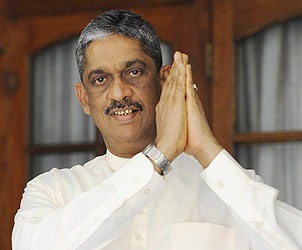 In the mud slinging match going on between the Rajapaksa and the Fonseka camps in the run up to the Sri Lankan Presidential election on January 26, the opposition candidate Gen.Sarath Fonseka said on Sunday, that Defence Secretary Gotabaya Rajapaksa had ordered army troops to kill three top LTTE leaders who were coming to surrender showing white flags.
In the mud slinging match going on between the Rajapaksa and the Fonseka camps in the run up to the Sri Lankan Presidential election on January 26, the opposition candidate Gen.Sarath Fonseka said on Sunday, that Defence Secretary Gotabaya Rajapaksa had ordered army troops to kill three top LTTE leaders who were coming to surrender showing white flags.
In an interview to The Sunday Leader Gen.Fonseka said that Gotabaya had asked the commander of the 58 Division Col.Shavendra Silva to kill Seevaratnam Puleedevan (the head of the LTTE’s Peace Secretariat); Balasingham Nandesan (head of the political wing) and Ramesh ( a top military commander) and their families, if they came to the army lines to surrender holding up white flags.
Fonseka said that as per the order, the three men and their entourage were shot dead as they came showing white flags.
GOTABAYA ASKED THEM TO COME WITH WHITE FLAGS
Hours before their attempted surrender, the three men had made appeals to the international community, especially Norway, to intervene and enable them and the LTTE to surrender to the Sri Lankan forces in an oderly way and close the fighting.
A flurry of e-mails and phone calls resulted in the Sri Lankan government’s agreeing to accept the surrender of the three leaders and their families.
Gen.Fonseka said that Basil Rajapaksa, the Sri Lankan President’s brother and Senior Advisor; Gotabaya Rajapaksa, another brother and Defence Secretary, had agreed to the surrender. The three Tiger leaders were asked to approach the lines of the 58 Division in a non threatening manner holding high pieces of white cloth.
“This was their (the Rajapaksa brothers’) idea,” Gen.Fonseka said.
The then Foreign Secretary, Dr.Palitha Kohona, who was negotiating with the international community and Norway on this issue, had said on three occassions that the men could surrender in the way combatants surrendered in war.
The three LTTE leaders and their familes did, as asked, on the night of May 17-18.But they were shot dead, General Fonseka said.
Significantly, Gen. Fonseka, who was Army Commander then, was not in Sri Lanka between May 10 and 17. He had arrived only a day before the end of the fighting.
When The Sunday Leader asked Col (now Maj.Gen) Shavendra Silva Commander of the 58 Division, whether Gen.Fonseka was telling the truth about the incident, the officer said that it was for the military spokesman, Brig.Udaya Nanayakkara, to answer the question.
Brig.Nanayakkara contacted the Army Commander Gen.Jagath Jayasuriya and Gen.Shavendra Silva and came back to say that neither of them would comment on the allegation.
Earlier, while he was army commander, Gen.Fonseka had told a gathering at his home town of Ambalangoda in south Sri Lanka, that the war was fought under his leadership in an innovative and unconventional way, with the army even shooting down LTTE cadre who came to surrender.
The reference was clearly to the May 17-18 incident involving Puleedevan, Nadesan and Ramesh, but he did not mention their names.Fonseka also did not point an accusing finger at Gotabaya or any of the Rajapaksa brothers at that time. This was because there was no rift between him and the Rajapaksas at that time.
FONSEKA READY FOR WAR CRIMES TRIBUNAL
Later, after resigning from the post of Chief of Defence Staff and the army, and becoming an opposition candidate for the Sri Lankan Presidency, Gen.Fonseka told the media that he was not against an international war crimes tribunal going into excesses committed in the last phase of the war.
“If there is credible evidence of any human rights violation,it should be investigated.The Sri Lankan army has nothing to hide,” he said.
This statement compromised the Rajapaksa government’s stand that there was no case for a war crimes tribunal because Sri Lanka had fought and defeated the world’s most ruthless terrorist group ,the LTTE, and restored peace and normalcy to after thirty years of relentless bloodshed.
US ROLE
The United States had been leading the international pack seeking a war crimes probe in Sri Lanka. The State Department presented a report to the US Congress listing the human rights violations committed by the Sri Lankan forces (and also the LTTE) during the war.
The report was sent to the Sri Lankan government for its comments. Colombo protested vehemently but set up an experts committee to study the report and reply point by point.
Meanwhile, the US authorities questioned Defence Secretary Gotabaya, who is an American citizen, while he was in New York to attend the last UN General Assembly session. Gen.Fonseka was asked to appear before an official of the internal security department when he was in Oklahoma to fulfil a residence requirement attached to his status in the US as a Green Card holder. Gen.Fonseka told the Sri Lankan government that an US official had asked him to testify against the Defence Secretary in any investigation into war crimes.
The Sri Lankan government protested but finally managed to convince the US government to excuse Gen.Fonseka from the interview with the internal security authorities and let him return to Sri Lanka forthwith.
Gen.Fonseka obeyed Colombo’s orders and returned to Sri Lanka, because he had not broken off with the Sri Lankan government and the Rajapaksas at that time.
(For updates you can share with your friends, follow TNN on Facebook and Twitter )
